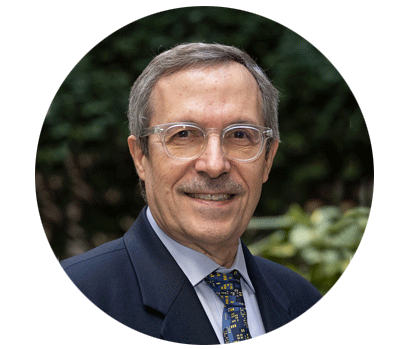

LVII Jiménez Díaz Commemorative Lecture
Onsite – Online
Madrid, May 19, 2025. 9:00 -13:30
Hospital Universitario Fundación Jiménez Díaz
Conference Room. Avda. Reyes Católicos, 2. Madrid
Prof. Josep Dalmau Obrador
“Autoimmune encephalitis:
What we have learned within and beyond neurology”
Professor Josep Dalmau is a neurologist and world-renowned researcher in the study of autoimmune and paraneoplastic disorders and the discoverer of a new category of antibody-mediated diseases that often respond to immunological treatment.

Fundación Conchita Rábago

The Fundación Conchita Rábago was established in 1969 with the aim of preserving the memory and work of Professor Jiménez Díaz by promoting biomedical research and providing support to the Fundación Jiménez Díaz (FJD) in all its initiatives in this field.
The Fundación Conchita Rábago (FCR) was founded after the death of Professor Carlos Jiménez Díaz. His widow Conchita Rábago decided to create the Foundation, advised by her nephews Dr Gregorio de Rábago, Dr Pedro de Rábago and Dr Mariano Jiménez Casado, respectively the heads of the cardiovascular surgery, cardiology and internal medicine services of the FJD.
Advised by Mariano Jiménez Díaz and Professors Severo Ochoa, Alberto Sols and Santiago Grisolía, they decided to annually organize a commemorative lecture with international projection and top-level scientific lecturers. The simultaneous holding of a symposium was also agreed.
Professor Jiménez Díaz’s major concern was to promote research and to improve the training of his colleagues and students by placing them in prominent hospitals abroad. For that reason, the Fundación Conchita Rábago decided to annually award grants and aid to physicians and researchers from the Clínica de La Concepción.
More than 50 years have passed since the Foundation began operating in 1969. During this period, besides annually holding the commemorative lecture and corresponding symposium, more than a thousand research grants have been awarded.
50th Anniversary Jiménez Díaz Commemorative Lecture (download)
50th Anniversary Memory Jiménez Díaz Commemorative Lecture (download)

Prof. Carlos Jimenez Diaz
Professor Carlos Jiménez Díaz was born in Madrid in 1898. Besides his other achievements, he was one of Spain’s most outstanding medical doctors of the 20th century.
It was he who closed the then-prevalent cycle of dogmatic medicine with little scientific basis, opening a new era marked by modernization and alignment with the new world of medicine in the aspects of care, teaching and research. He was doubtless the last great total clinician, a “knower of all there is to know”, in the words of Laín Entralgo.
He addressed those three aspects of medicine and contributed the world’s first immunosuppressant treatment with nitrogen mustard, long before the use of steroids, in what were then known as damaging auto plasma disorders (nowadays as autoimmune diseases).
He defended the theory and conducted experimental work on “the transcendent role of the secretion of active substances via the vascular endothelium” in arterial hypertension and revolutionized the concept of allergy, besides performing the world’s second cardiac catheterization. He was the only Spanish physician who attained the honour of heading two international societies (Internal Medicine and Allergy).
In Spain he created the first medical research institute, enabling exclusive dedication to such work in its basic and clinical aspects. Subsequently, following the tragic interval of the Civil War, after which he had to start anew, he achieved his dream of a ‘total centre’ that would combine all aspects: the Clinica de la Concepción, later the Fundación Jiménez Díaz, in his honour. Thus began a stage in the pioneering transformation of the old concept of hospital into a place devoted to science, developing therein all specialties with their own services.
There he also modernized undergraduate and postgraduate teaching, taking the first steps toward formal specialization for new graduates.

Ms. Conchita de Rábago
María de la Concepción de Rábago Fernández was born in Madrid in 1898, although her family came from Cantabria.
She met the young Carlos Jiménez Díaz when she was fifteen years old during summer holidays in Cercedilla, a mountain town near Madrid. A few years later they wed at the church of La Almudena. They had no children.
She accompanied Carlos on his travels and enthusiastically supported all his projects. For many years their home served as a meeting place in the world of culture and the arts.
She died in May 1969, less than two years after Professor Jiménez Díaz.


History, Philosophy and Aims of the Foundation
Board of Trustees Fundación Conchita Rábago

Chair
Dr. Mr. Gregorio de Rábago Juan-Aracil
Sub-director of the Department of Cardiology and Cardiac Surgery
Clínica Universidad de Navarra

Member
Dr. Ms. Carmen Ayuso García
Scientific Director IIS-FJD
Head of the Genetics Service
Hospital Universitario Fundación Jiménez Díaz

Secretary
Mr. Luis Jiménez-Díaz Egoscozábal
Lawyer
Partner Jones Day Firm

Member
Dr. Ms. Rosa de Rábago Sociats
Assistant – Cardiology Service
Hospital Universitario Fundación Jiménez Díaz
Other positions in the Foundation

Adviser for life
Dr. Mr. Pedro de Rábago González

Manager
Mrs. Isabel Ferreiro Carrobles

Economic Adviser
Mr. José María Pinedo y de Noriega
Publications
Doctor Jiménez Díaz, Vida y Obra.
Dr. Jiménez Casado

This book is meant to recount his inspiring life and highlight his achievements to persons outside the medical profession, besides transmitting his example to new generations of physicians who did not have the privilege of studying under him directly.
Donwload PDF Book
Historia de mi instituto
Dr. Jiménez Diaz

The main character of this book tells his story: how a young physician during tough times had an impossible dream, which only came true after a great deal of effort and many years of struggle.
Concepto de la insuficiencia hepática
Dr. Jiménez Díaz

Facsimile edition of the publication by Professor Carlos Jiménez Díaz on the concept of liver failure edited by Javier Morata in 1929.



